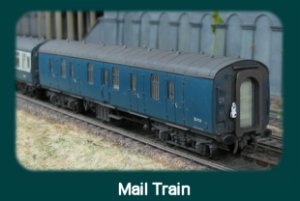*****************************************************************************************************************************************************************
A Down ECS sleeper train is captured en-route to the carriage sidings behind Brush type 2
number 5552. Three types of sleeping car were introduced in 1957 to the
standard mark 1 design, built at Doncaster, Wolverton, and York works, with 5 from
Metro Cammell. The 5 Met Cam built (W2574 to W2578) were slightly different to the BR
built types and are not suited to the Bachmann model.
SLF - Sleeper First - 2000 to 2132
SLC - Sleeper Composite - 2400 to 2454
SLSTP - Sleeper Second with attendant comp' - 2500 to 2691
All types allocated to the Eastern, Midland, Scottish and Western Regions.

This image shows SLF E2059, an all-first class vehicle with 11 single compartments, and is
one of the earlier Doncaster built examples (2000 - 2104) delivered with B1 bogies and later
changed to B5 bogies from 1966 onwards.

SLC E2435 with 5 first class compartments, and sleeping for 12 second class passengers in the 6
remaining compartments bunk bed style.

The SLC is an easy conversion from a SLF by removing part of the yellow band and
'1' symbol from the door, as these 2 types are externally identical compared to the SLSTP. This
model was from the initial batch by Bachmann, showing work to the roof and shorter duct modification.

SLSTP E2560 represents a BR Doncaster built vehicle with B5 bogies which were fitted to this
earlier batch of sleeping cars (2500 - 2573) in the late 1960s. The model is actually fitted with
Bachmann's B4 bogie which is very similar in appearance to the B5.

SLSTP E2668 is a later BR Wolverton built example (2579 - 2691) which were fitted with Commonwealth
bogies from the begining to the end of their lives.

There were many variations of sleeping car rakes and it was fairly common to see 1 full brake near
the front, and 2 tagged on the rear of the Anglo-Scottish formations.... as well as a couple of
GUVs behind the loco. Kadee number 5 buckeye couplings are used between the coaches, mounted on
the end of the body to happily negotiate 30" radius curves. Black folded paper is glued to one
coach whilst the adjacent coach has a blank buffing plate, and this arrangement closes the gap
between the carriages and provides a reasonable representation of a working gangway.

Some of the first releases of the Bachmann model resulted in the incorrect type of ducting
being fitted to some of the 4 colour/class variants.
The roof on SLF E2121 and all the other first class vehicles have been modified to the
corrected short version ducting and removal of 2 roof pod ventilators (repositioning one
of them). The longer ducts were only fitted to the second class vehicles,
shown on the SLSTP behind for comparison.
*****************************************************************************************************************************************************************












